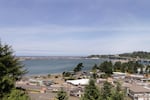
"Part of it that they underestimate the grit of the people who live here," said Waldport High School teacher Melissa Steinman. "Most of us had to deal with multiple day power outages, loss of access to our homes at some point due to flooding or sand."
John Rosman / OPB
In Portland, with a turn of a faucet, clean water flows at a cost of 1.9 gallons a penny.
The Bull Run watershed supplies the city and some neighbors, totaling about 25 percent of the state's population. Connecting the source with homes, businesses, fire hydrants, etc. is a series of pipes that if pulled apart could stretch from the Portland Water Bureau office to the Gulf of Mexico.
Unfortunately, this dizzying pipe network is like a series of Christmas lights. If a single pipe in the series breaks, the rest of the pipes down the line are likely to be affected. It's like this in lots of places.
"We experience about 20-25 major breaks a year that require mobilization of crews and so on," said Mark Knudson, CEO of the nearby Tualatin Water District.
Knudson worked as part of a commission to create The Oregon Resilience Plan (pdf). It's a detailed look at how the state's infrastructure would fare after the Cascadia Subduction Zone earthquake, the looming event that has a one-in-three chance of striking the Northwest in the next 50 years. The plan lays out suggestions for improvements that should be made before then.
He has seen projections of what that number of breaks would look like after the Cascadia quake — it skyrockets.
"Somewhere in the order of 3,000 to 3,500 significant leaks or breaks that'd have to be prepared," said Knudson. "So more than 10 times the number that we experience every year would occur in the matter of minutes."
If the earthquake struck right now it would take a couple of months (pdf) to get the water system fully operational in Portland and its suburbs. But it's an entirely different story on the Oregon Coast.
In the event of the Cascadia quake, the coast will be closest to the epicenter, fully in the tsunami zone and, due to its rural location, last in line for repairs. How long would it take for these systems to be rebuilt?
Related Content: Oregon's Tsunami Maps Are Dangerously Out Of Date
"It depends. Areas not affected by the tsunami, six months, in some cases a year. In other areas those systems don't get rebuilt," said Knudson. "Does it make sense? Do we rebuild those communities prone to a major earthquake or tsunami in the future?"
Althea Rizzo says that the challenges facing some of these coastal communities might be too great to overcome. She's the geological hazards coordinator for the Office of Emergency management.
"A lot of these communities will cease to exist. [Highway] 101 is absolutely going to cease to exist," said Rizzo. "That's a huge question to the folks living out on the coast — does their community survive?"
In a radio special as part of OPB's "Unprepared" series, we explore what water infrastructure can tell us about the survival of coastal communities after what could be the largest natural disaster in American history.






